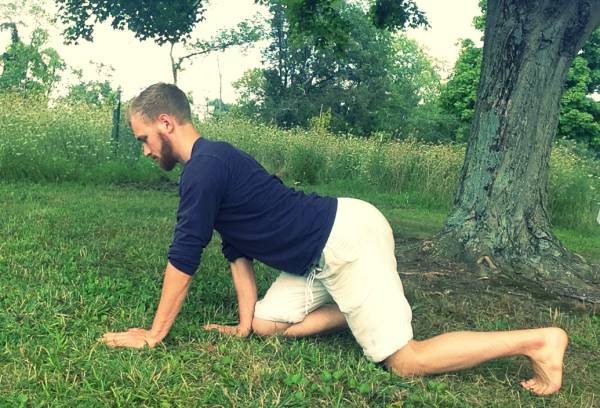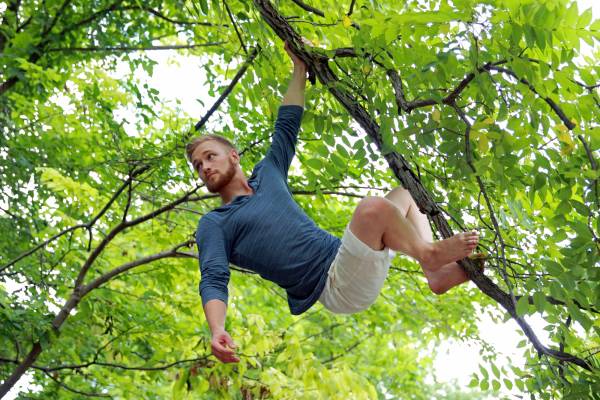You want to get better at handstands. You think to yourselves, “Maybe if I just try more handstands, I’ll be able to handstand better.” But it doesn’t quite work like that.
You’re inundated with Instagram images of impressive physical feats like handstands on a daily basis. And sure, it’s impressive. But it’s easy to forget that each picture is merely a snapshot of a physical practice. There are hours, days, and weeks of preparatory work needed to achieve these results.
I’m going to teach you the crucial order of operations for sustainable, injury-free handstand practice.
Handstands may look effortless, but they take a lot of preparatory work.
Alignment Matters
I’ll be the first to say, handstands are fun. The art and practice of hand-balancing is tremendously rewarding, both as a strength builder and for show. But it also opens up potential for serious injury when we don’t heed prerequisites. I’ve learned that the hard way.
A lifetime of sitting pretty much ensures that your body doesn’t work like a human body should. If you’re serious about building up to a handstand but don’t want to hurt yourself in the process, you can use natural movement to reclaim your human capability and safely prep your body.
You’re a living machine. As such, you need to ensure that your mechanical bits are in working order. Every movement, from handstands to deadlifts, is built on a coordinated effort of the joints involved. Your joints must function within their normal range of motion before you can load them. The body is a master of compensation. If one joint is out of alignment or lacks the necessary range of motion, surrounding tissues are forced to take the fall.
Let’s take a look at how to align some of the biggest troublemakers in a handstand.
Restore Wrist Flexibility
To effectively and efficiently hold a handstand, your wrists must be able to reach a relatively extreme range of extension (bending the hand back toward you). This position is unfamiliar for most people, as a majority of our daily functional tasks are accomplished around 40 degrees of extension.1 As the body generally follows the “use it or lose it” principle, you may not have the necessary range of motion any more.
Luckily there’s a natural human movement that can help you regain range of motion and strength in this position: crawling. I know, I know – I talk about crawling all the time. But the truth is, it’s a fundamental building block of human bipedalism. And handstanding is just another form of bipedalism, so it makes sense that crawling should be an integral part of your handstand progression.
Try This: Aim to spend 10 minutes each day crawling. Spread it throughout the day as needed, but build up to 10 minutes on hands and feet daily. Crawling is a fantastic warm up for regular training days, or you can sneak in a few minutes in the morning or evening. You’ll quickly see improvement in your whole physical practice.

Spend at least ten minutes a day crawling to restore wrist health.
Restore Shoulder Range of Motion
This is where we separate the arched back “banana handstands” we see on social media from the true handstands. Yes, it’s perfectly possible to hand balance without full shoulder range of motion, but your practice will be limited, and your shoulder health will suffer. Kinesiology doesn’t spare feelings.
To find renewed space in your shoulders, you’ll need to unravel years spent at a desk hunched over a computer. The shoulder slump stops many aspiring hand balancers dead in their tracks. Fortunately, opening up the shoulder girdle is as simple as engaging your inner monkey.
Start things off by reaching up to a bar or rings overhead. We rarely use this range of motion in our day-to-day life, but reaching overhead is a critical step in reclaiming that range of motion. The joints need to be able to find their full range without load before adding intensity.
If you find that you’re able to easily and comfortably reach overhead, it’s time to brachiate. Brachiation, the practice of supporting yourself while hanging from your hands, is a key piece of the puzzle for building strength and stability in the shoulder girdle.
Try This: Ease into hanging from a low bar, keeping your feet on the ground. This will allow you to manage how much stress you introduce to the arms. Start with 5-10 intervals of 30 seconds. You will gradually learn to support more of your weight in your hands. When you can hang free of support, lengthen your intervals up to 40 or 50 seconds, working up to a minute. Keep in mind, if you aren’t accustomed to this range, you’ll quickly tire out the shoulders, so take frequent breaks. Better to build a strong foundation than to rush the process.

Brachiation restores strength and stability in the shoulder girdle.
Prerequisites Matter
It’s easy to get caught up in the quest of shiny new movements, but we can’t escape the reality of the physical body. Before you dive into new skills, make sure you have the necessary prerequisites. Sufficient range of motion and stability in the wrist and shoulder joints never go out of style, and they’ll help you avoid injury as you deepen your practice.
Natural movements like crawling and brachiating are crucial for ensuring that your body works the way a body should before going upside down. It took you many months of natural movement to learn to stand on your own two feet. Why would standing on your hands be any different?
You’ll Also Enjoy:
- 5 Steps to Work Through Your Fear of Handstands
- How to Crawl Your Way Back to Shoulder Health
- 3 Drills for Building Wrist Flexibility
- New on Pulse Beat Fit Today
References:
1. Ryu JY, et al. “Functional Ranges of Motion of the Wrist Joint,” Journal of Hand Surgery 16 (1991): 409-419.
Photos courtesy of Chandler Stevens.






